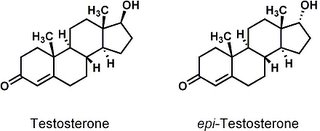Cramming for the test

Steroids are in the spotlight this weekend, as we prepare for the results from the test of Floyd Landis's "B" sample. The issue at hand: Landis, the American winner of this year's Tour de France, tested positive for testosterone use after stage 17 of the Tour, which is where he mounted a dramatic comeback to retake the lead.
aside: Stephen Colbert's response a few days back, "Of course he tested high for testosterone! He's a red-blooded American!"
Cycling authorities state that Landis had provided a backup urine sample from that stage that is being tested as we speak to confirm the results and rule out contamination, etc. All this drama in a Tour de France already tainted by a doping scandal.
Testing for anabolic steroid abuse is a complicated process. Anabolic, by the way, loosely translates to constructive metabolism, "building up" or "reconstructing". Testosterone occurs naturally in the human body, but the levels vary enough from person to person that it's difficult to gauge what is normal. Instead, authorities test the ratio of testosterone to epitestosterone, nicknamed the T/E ratio. The chemical structures of the two are actually very similar, but right now, it's not clear what function epitestosterone might have. We know a lot about what testosterone does. Amazing what one little -OH group is worth.
There is a much better post here about the intricacies of conditions leading to low epitestosterone, anti-doping legislation and the testing involved.
An alternate test exists which uses mass spectrometry to distinguish synthetic testosterone from natural testosterone. A coworker of mine said that this had been mentioned in a news broadcast (can't remember where) and like good scientists, we were skeptical. Huh? How could that work? The masses should be the same! Turns out, it was just a case of oversimplification. Most people probably couldn't care less about the details, but I hold you to a higher standard, gentle reader.
The mass spectrometer can detect differences in the ratio of the two stable carbon isotopes, 13C and 12C. Isotopes of the same element have slightly different masses. Synthetic testosterone contains less 13C than the naturally occurring kind. Fox News says that most synthetic testosterone comes from soy. This post doesn't mention soybeans specifically, but goes into the details of how different plants end up with different 13C content based on how exactly they take in nutrients from photosynthesis.
The problem I see with measuring a ratio is that Landis's high reading could be due to high testosterone levels or a low excretion of epitestosterone. Also, I would think that if this were a case of doping, why couldn't he just administer epitestosterone, too? Anybody know the pharmacokinetic data for these? Maybe one's excreted much faster?
This paper describes how to use mass spectrometry to detect artificial epitestosterone.
Clinical Chemistry 2002, 48, 629-636.
It takes a little creativity to think of new tests, as there will always be new ways to mask cheating. Slightly off-topic: A college friend wrote her undergrad thesis in collaboration with the NJ State Police; she was trying to find a better way to test for gamma-hydroxybutyrate, a date rape drug.
Another test I thought was cool: Physicians can measure the levels of insulin C-peptide in patients with type 1 diabetes to see whether the pancreas is making any insulin on its own. The insulin that diabetics inject into their bodies is made without C-peptide, because it's not necessary for the insulin to work.
From MedLine Plus:
When insulin is synthesized by the beta cells of the pancreas, it is produced as a large molecule (a propeptide). This molecule is then split into two pieces: insulin and C-peptide. The function of C-peptide is not known.
Normal values in a patient requiring insulin injections indicate that the person's body is still producing some insulin. Normal values in a patient who has low blood sugar indicate that the patient is making too much insulin.
Low values (or no Insulin C-peptide) indicate that the person's pancreas is producing little or no insulin.
--------------------------
Update 8/9/06
I hadn't noticed that In the Pipeline blogged this a few days before. Read the post for some insight as to why the soy plant has a lower 13C content.
Labels: current events


2 Comments:
Hi, just found your blog and really like it.
I have always thought that it would be fun to have the riders in the tour-de-france be average people like me. Since the Tour = big $$, all the pro riders have physicians who guide them in their training and nutrition, ensuring that they are at their "peak".
Average people would give a more honest race, although less excting.
As an aside, do you do synthetic chem or are you a biologist in a chem group? Just curious. I really like seeing multi-disciplinary research groups, especially chemistry based ones.
Thanks Milo.
To answer your question, a little from column a and a little from column b. The total synthesis I worked on is published, and I work with collaborators on biology-oriented projects.
Post a Comment
<< Home